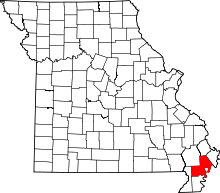North Lilbourn, Missouri
| North Lilbourn, Missouri | |
|---|---|
| Village | |
 Location of North Lilbourn, Missouri | |
| Coordinates: 36°36′2″N 89°37′15″W / 36.60056°N 89.62083°WCoordinates: 36°36′2″N 89°37′15″W / 36.60056°N 89.62083°W | |
| Country | United States |
| State | Missouri |
| County | New Madrid |
| Area[1] | |
| • Total | 0.17 sq mi (0.44 km2) |
| • Land | 0.17 sq mi (0.44 km2) |
| • Water | 0 sq mi (0 km2) |
| Elevation | 282 ft (86 m) |
| Population (2010)[2] | |
| • Total | 49 |
| • Estimate (2012[3]) | 48 |
| • Density | 288.2/sq mi (111.3/km2) |
| Time zone | Central (CST) (UTC-6) |
| • Summer (DST) | CDT (UTC-5) |
| ZIP code | 63862 |
| Area code(s) | 573 |
| FIPS code | 29-53138[4] |
| GNIS feature ID | 0723478[5] |
North Lilbourn is a village in New Madrid County, Missouri, United States. The population was 49 at the 2010 census.
Geography
According to the United States Census Bureau, the village has a total area of 0.17 square miles (0.44 km2), all of it land.[1][6]
Demographics
| Historical population | |||
|---|---|---|---|
| Census | Pop. | %± | |
| 1960 | 301 | — | |
| 1970 | 334 | 11.0% | |
| 1980 | 237 | −29.0% | |
| 1990 | 157 | −33.8% | |
| 2000 | 95 | −39.5% | |
| 2010 | 49 | −48.4% | |
| Est. 2015 | 47 | [7] | −4.1% |
2010 census
As of the census[2] of 2010, there were 49 people, 22 households, and 12 families residing in the village. The population density was 288.2 inhabitants per square mile (111.3/km2). There were 30 housing units at an average density of 176.5 per square mile (68.1/km2). The racial makeup of the village was 14.29% White and 85.71% Black or African American.
There were 22 households of which 18.2% had children under the age of 18 living with them, 22.7% were married couples living together, 13.6% had a female householder with no husband present, 18.2% had a male householder with no wife present, and 45.5% were non-families. 45.5% of all households were made up of individuals and 27.2% had someone living alone who was 65 years of age or older. The average household size was 2.23 and the average family size was 3.00.
The median age in the village was 45.1 years. 14.3% of residents were under the age of 18; 6.1% were between the ages of 18 and 24; 28.6% were from 25 to 44; 30.6% were from 45 to 64; and 20.4% were 65 years of age or older. The gender makeup of the village was 63.3% male and 36.7% female.
2000 census
As of the census[4] of 2000, there were 95 people, 37 households, and 23 families residing in the village. The population density was 550.3 people per square mile (215.8/km²). There were 46 housing units at an average density of 266.4 per square mile (104.5/km²). The racial makeup of the village was 5.26% White, 93.68% African American, and 1.05% from two or more races.
There were 37 households out of which 27.0% had children under the age of 18 living with them, 18.9% were married couples living together, 32.4% had a female householder with no husband present, and 37.8% were non-families. 37.8% of all households were made up of individuals and 21.6% had someone living alone who was 65 years of age or older. The average household size was 2.57 and the average family size was 3.35.
In the village the population was spread out with 30.5% under the age of 18, 6.3% from 18 to 24, 23.2% from 25 to 44, 22.1% from 45 to 64, and 17.9% who were 65 years of age or older. The median age was 36 years. For every 100 females there were 93.9 males. For every 100 females age 18 and over, there were 88.6 males.
The median income for a household in the village was $11,563, and the median income for a family was $23,333. Males had a median income of $25,313 versus $15,250 for females. The per capita income for the village was $7,654. There were 36.7% of families and 38.2% of the population living below the poverty line, including 40.0% of under eighteens and 28.6% of those over 64.
References
- 1 2 "US Gazetteer files 2010". United States Census Bureau. Retrieved 2012-07-08.
- 1 2 "American FactFinder". United States Census Bureau. Retrieved 2012-07-08.
- ↑ "Population Estimates". United States Census Bureau. Retrieved 2013-05-30.
- 1 2 "American FactFinder". United States Census Bureau. Retrieved 2008-01-31.
- ↑ "US Board on Geographic Names". United States Geological Survey. 2007-10-25. Retrieved 2008-01-31.
- ↑ "US Gazetteer files: 2010, 2000, and 1990". United States Census Bureau. 2011-02-12. Retrieved 2011-04-23.
- ↑ "Annual Estimates of the Resident Population for Incorporated Places: April 1, 2010 to July 1, 2015". Retrieved July 2, 2016.
- ↑ "Census of Population and Housing". Census.gov. Retrieved June 4, 2015.
